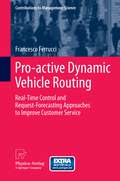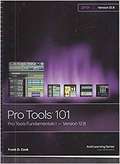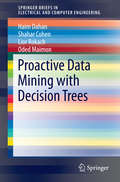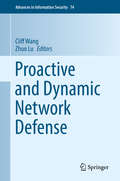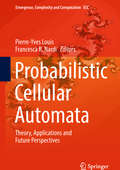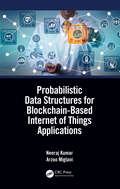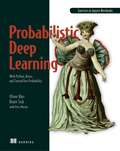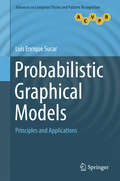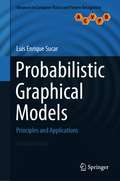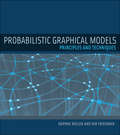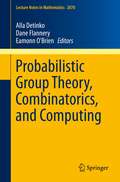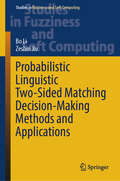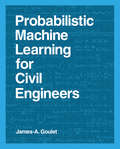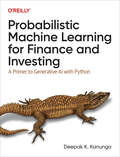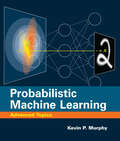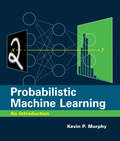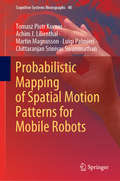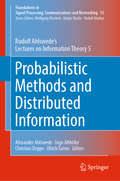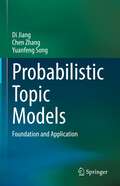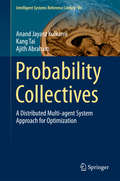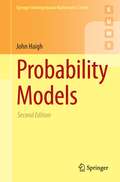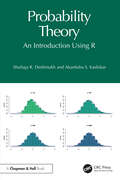- Table View
- List View
Pro-active Dynamic Vehicle Routing
by Francesco FerrucciThis book deals with transportation processes denoted as the Real-time Distribution of Perishable Goods (RDOPG). The book presents three contributions that are made to the field of transportation. First, a model considering the minimization of customer inconvenience is formulated. Second, a pro-active real-time control approach is proposed. Stochastic knowledge is generated from past request information by a new forecasting approach and is used in the pro-active approach to guide vehicles to request-likely areas before real requests arrive there. Various computational results are presented to show that in many cases the pro-active approach is able to achieve significantly improved results. Moreover, a measure for determining the structural quality of request data sets is also proposed. The third contribution of this book is a method that is presented for considering driver inconvenience aspects which arise from vehicle en-route diversion activities. Specifically, this method makes it possible to restrict the number of performed vehicle en-route diversion activities.
ProBlogger
by Darren Rowse Chris GarrettAn update of one of the bestselling blogging books, written by two of the world's most successful bloggersThere's a reason why the first two editions of this book have sold thousands of copies worldwide. Written by two of the world's most successful bloggers, it's one of the clearest books out there on how to earn an income from your blog. This new edition gets you up to date on the very latest changes that affect the blogging-for-business landscape. Featuring new material on Twitter, Facebook, and LinkedIn; plus new ways and tools to grow your audience and expand your business beyond your blog, this professional blogger's bible is better than ever. Helps novices choose a blog topic, analyze the market, set up a blog, promote it, and earn revenueGives aspiring bloggers proven techniques and the tools they need to succeed in building a business from their blogsReveals 20 key ingredients for a successful blog postOffers solid, step-by-step instruction on how bloggers actually make money, why niches matter, how to use essential blogging tools and take advantage of social media and content aggregators, how to optimize your advertising, and much moreIncludes techniques for attracting and growing an audience and how to mine new business opportunities beyond your blogWritten by two fulltime professional bloggers, this exciting, updated edition of ProBlogger tells you exactly how to launch and maintain a blog that makes money.
ProTools 110: Protools Fundamentals II
by Frank D. CookPro Tools 101: Pro Tools Fundamentals I takes a comprehensive look at the basics of using a Pro Tools system for audio production. Freshly updated for Pro Tools 2020 software, this 14th edition covers everything you need to know to complete a Pro Tools project. Learn to build sessions that include multitrack recordings of live instruments, MIDI sequences, and virtual instruments. Through hands-on exercises and projects, develop essential techniques for recording, editing, and mixing.
Proactive Data Mining with Decision Trees
by Lior Rokach Haim Dahan Shahar Cohen Oded MaimonThis book explores a proactive and domain-driven method to classification tasks. This novel proactive approach to data mining not only induces a model for predicting or explaining a phenomenon, but also utilizes specific problem/domain knowledge to suggest specific actions to achieve optimal changes in the value of the target attribute. In particular, the authors suggest a specific implementation of the domain-driven proactive approach for classification trees. The book centers on the core idea of moving observations from one branch of the tree to another. It introduces a novel splitting criterion for decision trees, termed maximal-utility, which maximizes the potential for enhancing profitability in the output tree. Two real-world case studies, one of a leading wireless operator and the other of a major security company, are also included and demonstrate how applying the proactive approach to classification tasks can solve business problems. Proactive Data Mining with Decision Trees is intended for researchers, practitioners and advanced-level students.
Proactive and Dynamic Network Defense (Advances in Information Security #74)
by Cliff Wang Zhuo LuThis book discusses and summarizes current research issues, identifies challenges, and outlines future directions for proactive and dynamic network defense. This book also presents the latest fundamental research results toward understanding proactive and dynamic network defense by top researchers in related areas. It includes research results that offer formal frameworks to define proactive and dynamic network defense, and develop novel models to analyze and evaluate proactive designs and strategies in computer systems, network systems, cyber-physical systems and wireless networks. A wide variety of scientific techniques have been highlighted to study these problems in the fundamental domain. As the convergence of our physical and digital worlds grows fast pace, protecting information systems from being tampered or unauthorized access is becoming one of the most importance issues. The traditional mechanisms of network defense are built upon a static, passive, and reactive nature, which has insufficient to defend against today's attackers that attempt to persistently analyze, probe, circumvent or fool such mechanisms. It has not yet been fully investigated to address the early stage of “cyber kill chain” when adversaries carry out sophisticated reconnaissance to plan attacks against a defense system. Recently, proactive and dynamic network defense has been proposed as an important alternative towards comprehensive network defense. Two representative types of such defense are moving target defense (MTD) and deception-based techniques. These emerging approaches show great promise to proactively disrupt the cyber-attack kill chain and are increasingly gaining interest within both academia and industry. However, these approaches are still in their preliminary design stage. Despite the promising potential, there are research issues yet to be solved regarding the effectiveness, efficiency, costs and usability of such approaches. In addition, it is also necessary to identify future research directions and challenges, which is an essential step towards fully embracing proactive and dynamic network defense. This book will serve as a great introduction for advanced-level computer science and engineering students who would like to start R&D efforts in the field of proactive and dynamic network defense. Researchers and professionals who work in this related field will also find this book useful as a reference.
Probabilistic Cellular Automata: Theory, Applications And Future Perspectives (Emergence, Complexity And Computation Ser. #27)
by Pierre-Yves Louis Francesca R. NardiThis book explores Probabilistic Cellular Automata (PCA) from the perspectives of statistical mechanics, probability theory, computational biology and computer science. PCA are extensions of the well-known Cellular Automata models of complex systems, characterized by random updating rules. Thanks to their probabilistic component, PCA offer flexible computing tools for complex numerical constructions, and realistic simulation tools for phenomena driven by interactions among a large number of neighboring structures. PCA are currently being used in various fields, ranging from pure probability to the social sciences and including a wealth of scientific and technological applications. This situation has produced a highly diversified pool of theoreticians, developers and practitioners whose interaction is highly desirable but can be hampered by differences in jargon and focus. This book – just as the workshop on which it is based – is an attempt to overcome these difference and foster interest among newcomers and interaction between practitioners from different fields. It is not intended as a treatise, but rather as a gentle introduction to the role and relevance of PCA technology, illustrated with a number of applications in probability, statistical mechanics, computer science, the natural sciences and dynamical systems. As such, it will be of interest to students and non-specialists looking to enter the field and to explore its challenges and open issues.
Probabilistic Data Structures for Blockchain-Based Internet of Things Applications
by Neeraj Kumar Arzoo MiglaniThis book covers theory and practical knowledge of Probabilistic data structures (PDS) and Blockchain (BC) concepts. It introduces the applicability of PDS in BC to technology practitioners and explains each PDS through code snippets and illustrative examples. Further, it provides references for the applications of PDS to BC along with implementation codes in python language for various PDS so that the readers can gain confidence using hands on experience. Organized into five sections, the book covers IoT technology, fundamental concepts of BC, PDS and algorithms used to estimate membership query, cardinality, similarity and frequency, usage of PDS in BC based IoT and so forth.
Probabilistic Deep Learning: With Python, Keras and TensorFlow Probability
by Beate Sick Oliver DuerrProbabilistic Deep Learning is a hands-on guide to the principles that support neural networks. Learn to improve network performance with the right distribution for different data types, and discover Bayesian variants that can state their own uncertainty to increase accuracy. This book provides easy-to-apply code and uses popular frameworks to keep you focused on practical applications.Summary Probabilistic Deep Learning: With Python, Keras and TensorFlow Probability teaches the increasingly popular probabilistic approach to deep learning that allows you to refine your results more quickly and accurately without much trial-and-error testing. Emphasizing practical techniques that use the Python-based Tensorflow Probability Framework, you&’ll learn to build highly-performant deep learning applications that can reliably handle the noise and uncertainty of real-world data. Purchase of the print book includes a free eBook in PDF, Kindle, and ePub formats from Manning Publications. About the technology The world is a noisy and uncertain place. Probabilistic deep learning models capture that noise and uncertainty, pulling it into real-world scenarios. Crucial for self-driving cars and scientific testing, these techniques help deep learning engineers assess the accuracy of their results, spot errors, and improve their understanding of how algorithms work. About the book Probabilistic Deep Learning is a hands-on guide to the principles that support neural networks. Learn to improve network performance with the right distribution for different data types, and discover Bayesian variants that can state their own uncertainty to increase accuracy. This book provides easy-to-apply code and uses popular frameworks to keep you focused on practical applications. What's inside Explore maximum likelihood and the statistical basis of deep learning Discover probabilistic models that can indicate possible outcomes Learn to use normalizing flows for modeling and generating complex distributions Use Bayesian neural networks to access the uncertainty in the model About the reader For experienced machine learning developers. About the author Oliver Dürr is a professor at the University of Applied Sciences in Konstanz, Germany. Beate Sick holds a chair for applied statistics at ZHAW and works as a researcher and lecturer at the University of Zurich. Elvis Murina is a data scientist. Table of Contents PART 1 - BASICS OF DEEP LEARNING 1 Introduction to probabilistic deep learning 2 Neural network architectures 3 Principles of curve fitting PART 2 - MAXIMUM LIKELIHOOD APPROACHES FOR PROBABILISTIC DL MODELS 4 Building loss functions with the likelihood approach 5 Probabilistic deep learning models with TensorFlow Probability 6 Probabilistic deep learning models in the wild PART 3 - BAYESIAN APPROACHES FOR PROBABILISTIC DL MODELS 7 Bayesian learning 8 Bayesian neural networks
Probabilistic Graphical Models
by Luis Enrique SucarThis accessible text/reference provides a general introduction to probabilistic graphical models (PGMs) from an engineering perspective. The book covers the fundamentals for each of the main classes of PGMs, including representation, inference and learning principles, and reviews real-world applications for each type of model. These applications are drawn from a broad range of disciplines, highlighting the many uses of Bayesian classifiers, hidden Markov models, Bayesian networks, dynamic and temporal Bayesian networks, Markov random fields, influence diagrams, and Markov decision processes. Features: presents a unified framework encompassing all of the main classes of PGMs; describes the practical application of the different techniques; examines the latest developments in the field, covering multidimensional Bayesian classifiers, relational graphical models and causal models; provides exercises, suggestions for further reading, and ideas for research or programming projects at the end of each chapter.
Probabilistic Graphical Models: Principles and Applications (Advances in Computer Vision and Pattern Recognition)
by Luis Enrique SucarThis fully updated new edition of a uniquely accessible textbook/reference provides a general introduction to probabilistic graphical models (PGMs) from an engineering perspective. It features new material on partially observable Markov decision processes, graphical models, and deep learning, as well as an even greater number of exercises.The book covers the fundamentals for each of the main classes of PGMs, including representation, inference and learning principles, and reviews real-world applications for each type of model. These applications are drawn from a broad range of disciplines, highlighting the many uses of Bayesian classifiers, hidden Markov models, Bayesian networks, dynamic and temporal Bayesian networks, Markov random fields, influence diagrams, and Markov decision processes.Topics and features:Presents a unified framework encompassing all of the main classes of PGMsExplores the fundamental aspects of representation, inference and learning for each techniqueExamines new material on partially observable Markov decision processes, and graphical modelsIncludes a new chapter introducing deep neural networks and their relation with probabilistic graphical models Covers multidimensional Bayesian classifiers, relational graphical models, and causal modelsProvides substantial chapter-ending exercises, suggestions for further reading, and ideas for research or programming projectsDescribes classifiers such as Gaussian Naive Bayes, Circular Chain Classifiers, and Hierarchical Classifiers with Bayesian NetworksOutlines the practical application of the different techniquesSuggests possible course outlines for instructorsThis classroom-tested work is suitable as a textbook for an advanced undergraduate or a graduate course in probabilistic graphical models for students of computer science, engineering, and physics. Professionals wishing to apply probabilistic graphical models in their own field, or interested in the basis of these techniques, will also find the book to be an invaluable reference.Dr. Luis Enrique Sucar is a Senior Research Scientist at the National Institute for Astrophysics, Optics and Electronics (INAOE), Puebla, Mexico. He received the National Science Prize en 2016.
Probabilistic Graphical Models: Principles and Techniques (Adaptive Computation and Machine Learning series)
by Daphne Koller Nir FriedmanA general framework for constructing and using probabilistic models of complex systems that would enable a computer to use available information for making decisions.Most tasks require a person or an automated system to reason—to reach conclusions based on available information. The framework of probabilistic graphical models, presented in this book, provides a general approach for this task. The approach is model-based, allowing interpretable models to be constructed and then manipulated by reasoning algorithms. These models can also be learned automatically from data, allowing the approach to be used in cases where manually constructing a model is difficult or even impossible. Because uncertainty is an inescapable aspect of most real-world applications, the book focuses on probabilistic models, which make the uncertainty explicit and provide models that are more faithful to reality. Probabilistic Graphical Models discusses a variety of models, spanning Bayesian networks, undirected Markov networks, discrete and continuous models, and extensions to deal with dynamical systems and relational data. For each class of models, the text describes the three fundamental cornerstones: representation, inference, and learning, presenting both basic concepts and advanced techniques. Finally, the book considers the use of the proposed framework for causal reasoning and decision making under uncertainty. The main text in each chapter provides the detailed technical development of the key ideas. Most chapters also include boxes with additional material: skill boxes, which describe techniques; case study boxes, which discuss empirical cases related to the approach described in the text, including applications in computer vision, robotics, natural language understanding, and computational biology; and concept boxes, which present significant concepts drawn from the material in the chapter. Instructors (and readers) can group chapters in various combinations, from core topics to more technically advanced material, to suit their particular needs.
Probabilistic Group Theory, Combinatorics, and Computing
by Alla Detinko Dane Flannery Eamonn O'BrienProbabilistic Group Theory, Combinatorics and Computing is based on lecture courses held at the Fifth de Brún Workshop in Galway, Ireland in April 2011. Each course discusses computational and algorithmic aspects that have recently emerged at the interface of group theory and combinatorics, with a strong focus on probabilistic methods and results. The courses served as a forum for devising new strategic approaches and for discussing the main open problems to be solved in the further development of each area. The book represents a valuable resource for advanced lecture courses. Researchers at all levels are introduced to the main methods and the state-of-the-art, leading up to the very latest developments. One primary aim of the book's approach and design is to enable postgraduate students to make immediate use of the material presented.
Probabilistic Linguistic Two-Sided Matching Decision-Making Methods and Applications (Studies in Fuzziness and Soft Computing #436)
by Zeshui Xu Bo LiThis book tackles the intricacies of decision-making processes where alternatives stem from distinct, finite sets. Discover the cutting-edge in decision-making with our groundbreaking book on complex two-sided matching methods. Harnessing the power of probabilistic linguistic term sets, it introduces innovative methods that enhance matching efficiency and practicality. It addresses the pressing question of how to navigate and optimize in scenarios with multifaceted matching challenges, offering an exploration into the psychological perceptions of agents through consistency checks and pairwise comparisons. It delves into the unknowns of static matching with multiple attribute weights, extends its scope to multi-sided agent sets in complex matching, and introduces dynamic screening mechanisms to refine the matching process. This book is not just a theoretical exploration. It lays the groundwork for intelligent matching algorithms and group mechanisms, providing actionable insights for technical supply and demand allocation, emergency personnel dispatch, and multi-stage medical management scheme selection. The effectiveness of these methods is backed by comparative analyses and simulation experiments, proving their superiority in real-world applications. Embrace the future of decision-making with our book, a must-read for those seeking to master complex matching scenarios and unlock practical solutions.
Probabilistic Machine Learning for Civil Engineers
by James-A. GouletAn introduction to key concepts and techniques in probabilistic machine learning for civil engineering students and professionals; with many step-by-step examples, illustrations, and exercises.This book introduces probabilistic machine learning concepts to civil engineering students and professionals, presenting key approaches and techniques in a way that is accessible to readers without a specialized background in statistics or computer science. It presents different methods clearly and directly, through step-by-step examples, illustrations, and exercises. Having mastered the material, readers will be able to understand the more advanced machine learning literature from which this book draws.The book presents key approaches in the three subfields of probabilistic machine learning: supervised learning, unsupervised learning, and reinforcement learning. It first covers the background knowledge required to understand machine learning, including linear algebra and probability theory. It goes on to present Bayesian estimation, which is behind the formulation of both supervised and unsupervised learning methods, and Markov chain Monte Carlo methods, which enable Bayesian estimation in certain complex cases. The book then covers approaches associated with supervised learning, including regression methods and classification methods, and notions associated with unsupervised learning, including clustering, dimensionality reduction, Bayesian networks, state-space models, and model calibration. Finally, the book introduces fundamental concepts of rational decisions in uncertain contexts and rational decision-making in uncertain and sequential contexts. Building on this, the book describes the basics of reinforcement learning, whereby a virtual agent learns how to make optimal decisions through trial and error while interacting with its environment.
Probabilistic Machine Learning for Finance and Investing: A Primer to Generative AI with Python
by Deepak K. KanungoThere are several reasons why probabilistic machine learning represents the next-generation ML framework and technology for finance and investing. This generative ensemble learns continually from small and noisy financial datasets while seamlessly enabling probabilistic inference, retrodiction, prediction, and counterfactual reasoning. Probabilistic ML also lets you systematically encode personal, empirical, and institutional knowledge into ML models.Whether they're based on academic theories or ML strategies, all financial models are subject to modeling errors that can be mitigated but not eliminated. Probabilistic ML systems treat uncertainties and errors of financial and investing systems as features, not bugs. And they quantify uncertainty generated from inexact inputs and outputs as probability distributions, not point estimates. This makes for realistic financial inferences and predictions that are useful for decision-making and risk management.Unlike conventional AI, these systems are capable of warning us when their inferences and predictions are no longer useful in the current market environment. By moving away from flawed statistical methodologies and a restrictive conventional view of probability as a limiting frequency, you’ll move toward an intuitive view of probability as logic within an axiomatic statistical framework that comprehensively and successfully quantifies uncertainty. This book shows you how.
Probabilistic Machine Learning: Advanced Topics (Adaptive Computation and Machine Learning series)
by Kevin P. MurphyAn advanced book for researchers and graduate students working in machine learning and statistics who want to learn about deep learning, Bayesian inference, generative models, and decision making under uncertainty.An advanced counterpart to Probabilistic Machine Learning: An Introduction, this high-level textbook provides researchers and graduate students detailed coverage of cutting-edge topics in machine learning, including deep generative modeling, graphical models, Bayesian inference, reinforcement learning, and causality. This volume puts deep learning into a larger statistical context and unifies approaches based on deep learning with ones based on probabilistic modeling and inference. With contributions from top scientists and domain experts from places such as Google, DeepMind, Amazon, Purdue University, NYU, and the University of Washington, this rigorous book is essential to understanding the vital issues in machine learning.Covers generation of high dimensional outputs, such as images, text, and graphs Discusses methods for discovering insights about data, based on latent variable models Considers training and testing under different distributionsExplores how to use probabilistic models and inference for causal inference and decision makingFeatures online Python code accompaniment
Probabilistic Machine Learning: An Introduction (Adaptive Computation and Machine Learning series)
by Kevin P. MurphyA detailed and up-to-date introduction to machine learning, presented through the unifying lens of probabilistic modeling and Bayesian decision theory.This book offers a detailed and up-to-date introduction to machine learning (including deep learning) through the unifying lens of probabilistic modeling and Bayesian decision theory. The book covers mathematical background (including linear algebra and optimization), basic supervised learning (including linear and logistic regression and deep neural networks), as well as more advanced topics (including transfer learning and unsupervised learning). End-of-chapter exercises allow students to apply what they have learned, and an appendix covers notation. Probabilistic Machine Learning grew out of the author&’s 2012 book, Machine Learning: A Probabilistic Perspective. More than just a simple update, this is a completely new book that reflects the dramatic developments in the field since 2012, most notably deep learning. In addition, the new book is accompanied by online Python code, using libraries such as scikit-learn, JAX, PyTorch, and Tensorflow, which can be used to reproduce nearly all the figures; this code can be run inside a web browser using cloud-based notebooks, and provides a practical complement to the theoretical topics discussed in the book. This introductory text will be followed by a sequel that covers more advanced topics, taking the same probabilistic approach.
Probabilistic Mapping of Spatial Motion Patterns for Mobile Robots (Cognitive Systems Monographs #40)
by Tomasz Piotr Kucner Achim J. Lilienthal Martin Magnusson Luigi Palmieri Chittaranjan Srinivas SwaminathanThis book describes how robots can make sense of motion in their surroundings and use the patterns they observe to blend in better in dynamic environments shared with humans.The world around us is constantly changing. Nonetheless, we can find our way and aren’t overwhelmed by all the buzz, since motion often follows discernible patterns. Just like humans, robots need to understand the patterns behind the dynamics in their surroundings to be able to efficiently operate e.g. in a busy airport. Yet robotic mapping has traditionally been based on the static world assumption, which disregards motion altogether. In this book, the authors describe how robots can instead explicitly learn patterns of dynamic change from observations, store those patterns in Maps of Dynamics (MoDs), and use MoDs to plan less intrusive, safer and more efficient paths. The authors discuss the pros and cons of recently introduced MoDs and approaches to MoD-informed motion planning, and provide an outlook on future work in this emerging, fascinating field.
Probabilistic Methods and Distributed Information: Rudolf Ahlswede’s Lectures on Information Theory 5 (Foundations in Signal Processing, Communications and Networking #15)
by Holger Boche Ingo Althöfer Christian Deppe Ulrich Tamm Alexander Ahlswede Rudolf Ahlswede Vladimir Blinovsky Ulrich Krengel Ahmed MansourThe fifth volume of Rudolf Ahlswede’s lectures on Information Theory focuses on several problems that were at the heart of a lot of his research. One of the highlights of the entire lecture note series is surely Part I of this volume on arbitrarily varying channels (AVC), a subject in which Ahlswede was probably the world's leading expert. Appended to Part I is a survey by Holger Boche and Ahmed Mansour on recent results concerning AVC and arbitrarily varying wiretap channels (AVWC). After a short Part II on continuous data compression, Part III, the longest part of the book, is devoted to distributed information. This Part includes discussions on a variety of related topics; among them let us emphasize two which are famously associated with Ahlswede: "multiple descriptions", on which he produced some of the best research worldwide, and "network coding", which had Ahlswede among the authors of its pioneering paper. The final Part IV on "Statistical Inference under Communication constraints" is mainly based on Ahlswede’s joint paper with Imre Csiszar, which received the Best Paper Award of the IEEE Information Theory Society. The lectures presented in this work, which consists of 10 volumes, are suitable for graduate students in Mathematics, and also for those working in Theoretical Computer Science, Physics, and Electrical Engineering with a background in basic Mathematics. The lectures can be used either as the basis for courses or to supplement them in many ways. Ph.D. students will also find research problems, often with conjectures, that offer potential subjects for a thesis. More advanced researchers may find questions which form the basis of entire research programs.
Probabilistic Topic Models: Foundation and Application
by Chen Zhang Di Jiang Yuanfeng SongThis book introduces readers to the theoretical foundation and application of topic models. It provides readers with efficient means to learn about the technical principles underlying topic models. More concretely, it covers topics such as fundamental concepts, topic model structures, approximate inference algorithms, and a range of methods used to create high-quality topic models. In addition, this book illustrates the applications of topic models applied in real-world scenarios. Readers will be instructed on the means to select and apply suitable models for specific real-world tasks, providing this book with greater use for the industry. Finally, the book presents a catalog of the most important topic models from the literature over the past decades, which can be referenced and indexed by researchers and engineers in related fields. We hope this book can bridge the gap between academic research and industrial application and help topic models play an increasingly effective role in both academia and industry. This book offers a valuable reference guide for senior undergraduate students, graduate students, and researchers, covering the latest advances in topic models, and for industrial practitioners, sharing state-of-the-art solutions for topic-related applications. The book can also serve as a reference for job seekers preparing for interviews.
Probability Collectives
by Ajith Abraham Anand Jayant Kulkarni Kang TaiThis book provides an emerging computational intelligence tool in the framework of collective intelligence for modeling and controlling distributed multi-agent systems referred to as Probability Collectives. In the modified Probability Collectives methodology a number of constraint handling techniques are incorporated, which also reduces the computational complexity and improved the convergence and efficiency. Numerous examples and real world problems are used for illustration, which may also allow the reader to gain further insight into the associated concepts.
Probability Models
by John HaighThe purpose of this book is to provide a sound introduction to the study of real-world phenomena that possess random variation. It describes how to set up and analyse models of real-life phenomena that involve elements of chance. Motivation comes from everyday experiences of probability, such as that of a dice or cards, the idea of fairness in games of chance, and the random ways in which, say, birthdays are shared or particular events arise. Applications include branching processes, random walks, Markov chains, queues, renewal theory, and Brownian motion. This popular second edition textbook contains many worked examples and several chapters have been updated and expanded. Some mathematical knowledge is assumed. The reader should have the ability to work with unions, intersections and complements of sets; a good facility with calculus, including integration, sequences and series; and appreciation of the logical development of an argument. Probability Models is designed to aid students studying probability as part of an undergraduate course on mathematics or mathematics and statistics.
Probability Theory: An Introduction Using R
by Shailaja R. Deshmukh Akanksha S. KashikarThis book introduces Probability Theory with R software and explains abstract concepts in a simple and easy-to-understand way by combining theory and computation. It discusses conceptual and computational examples in detail, to provide a thorough understanding of basic techniques and develop an enjoyable read for students seeking suitable material for self-study. It illustrates fundamental concepts including fields, sigma-fields, random variables and their expectations, various modes of convergence of a sequence of random variables, laws of large numbers and the central limit theorem. Computational exercises based on R software are included in each Chapter Includes a brief introduction to the basic functions of R software for beginners in R and serves as a ready reference Includes Numerical computations, simulation studies, and visualizations using R software as easy tools to explain abstract concepts Provides multiple-choice questions for practice Incorporates self-explanatory R codes in every chapter This textbook is for advanced students, professionals, and academic researchers of Statistics, Biostatistics, Economics and Mathematics.
Probability and Random Processes for Electrical and Computer Engineers
by John A. GubnerThe theory of probability is a powerful tool that helps electrical and computer engineers to explain, model, analyze, and design the technology they develop. The text begins at the advanced undergraduate level, assuming only a modest knowledge of probability, and progresses through more complex topics mastered at graduate level. The first five chapters cover the basics of probability and both discrete and continuous random variables. The later chapters have a more specialized coverage, including random vectors, Gaussian random vectors, random processes, Markov Chains, and convergence. Describing tools and results that are used extensively in the field, this is more than a textbook; it is also a reference for researchers working in communications, signal processing, and computer network traffic analysis. With over 300 worked examples, some 800 homework problems, and sections for exam preparation, this is an essential companion for advanced undergraduate and graduate students. Further resources for this title, including solutions (for Instructors only), are available online at www. cambridge. org/9780521864701.
Probability and Statistics for Data Science: Math + R + Data (Chapman & Hall/CRC Data Science Series)
by Norman MatloffProbability and Statistics for Data Science: Math + R + Data covers "math stat"—distributions, expected value, estimation etc.—but takes the phrase "Data Science" in the title quite seriously: <P><P> * Real datasets are used extensively. * All data analysis is supported by R coding. * Includes many Data Science applications, such as PCA, mixture distributions, random graph models, Hidden Markov models, linear and logistic regression, and neural networks. * Leads the student to think critically about the "how" and "why" of statistics, and to "see the big picture." * Not "theorem/proof"-oriented, but concepts and models are stated in a mathematically precise manner. <P><P> Prerequisites are calculus, some matrix algebra, and some experience in programming. <P><P> Norman Matloff is a professor of computer science at the University of California, Davis, and was formerly a statistics professor there. He is on the editorial boards of the Journal of Statistical Software and The R Journal. His book Statistical Regression and Classification: From Linear Models to Machine Learning was the recipient of the Ziegel Award for the best book reviewed in Technometrics in 2017. He is a recipient of his university's Distinguished Teaching Award.
